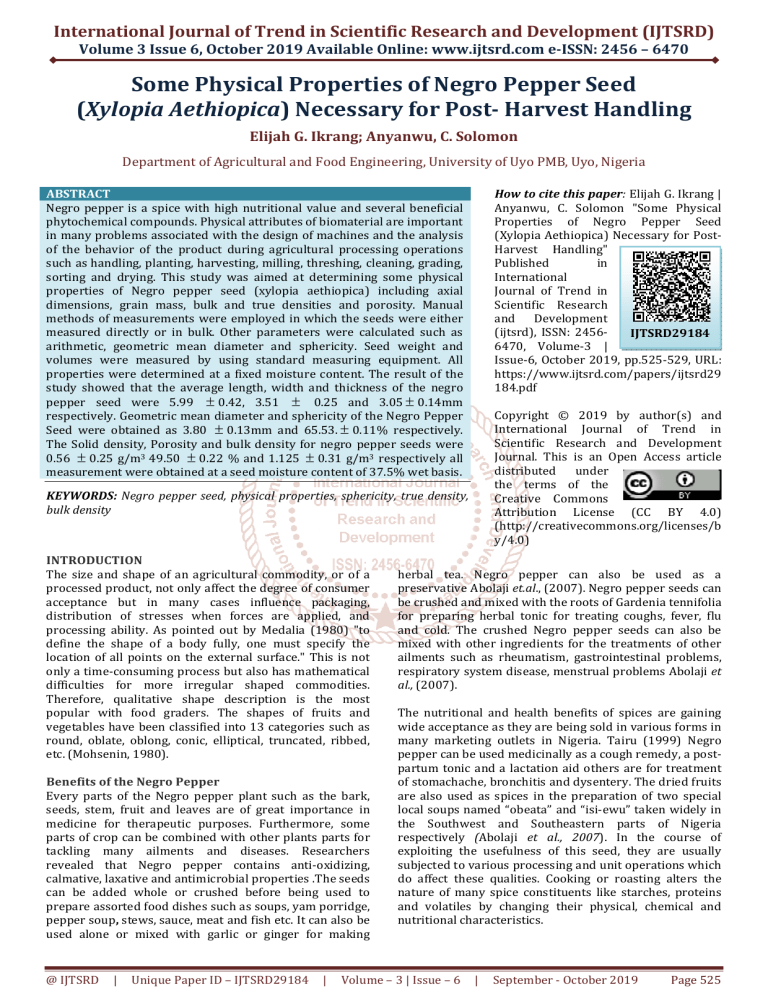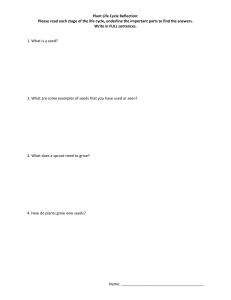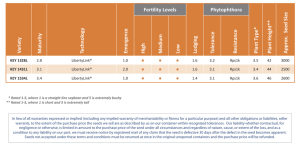
International Journal of Trend in Scientific Research and Development (IJTSRD)
Volume 3 Issue 6, October 2019 Available Online: www.ijtsrd.com e-ISSN:
e
2456 – 6470
Some Physical Properties of Negro Pepper Seed
(Xylopia
Xylopia Aethiopica)
Aethiopica Necessary for Post- Harvest Handling
Elijah G. Ikrang;
Ikrang Anyanwu, C. Solomon
Department off Agricultural and Food Engineering, University of Uyo PMB,
PMB Uyo, Nigeria
How to cite this paper:
paper Elijah G. Ikrang |
Anyanwu, C. Solomon "Some Physical
Properties of Negro Pepper Seed
(Xylopia Aethiopica) Necessary for PostPost
Harvest Handling"
Published
in
International
Journal of Trend in
Scientific Research
and Development
(ijtsrd), ISSN: 24562456
IJTSRD29184
6470, Volume
olume-3 |
Issue-6,
6, October 2019, pp.525-529,
pp.525
URL:
https://www.ijtsrd.com/papers/ijtsrd29
184.pdf
ABSTRACT
Negro pepper is a spice with high nutritional value and several beneficial
phytochemical compounds. Physical attributes of biomaterial are important
in many problems associated with the design of machines and the analysis
of the behavior of the product
roduct during agricultural processing operations
such as handling, planting, harvesting, milling, threshing, cleaning, grading,
sorting and drying. This study was aimed at determining some physical
properties of Negro pepper seed (xylopia
xylopia aethiopica)
aethiopica including axial
dimensions, grain mass, bulk and true densities and porosity. Manual
methods of measurements were employed in which the seeds were either
measured directly or in bulk. Other parameters were calculated such as
arithmetic, geometric mean diameter and sphericity. Seed weight and
volumes were measured by using standard measuring equipment. All
properties were determined at a fixed moisture content. The result of the
study showed that the average length, width and thickness of the negro
pepper seed were 5.99 ± 0.42, 3.51 ± 0.25 and 3.05 ± 0.14mm
respectively. Geometric mean diameter and sphericity of the Negro Pepper
Seed were obtained as 3.80 ± 0.13mm and 65.53. ± 0.11% respectively.
The Solid density, Porosity and bulk density for negro pepper seeds were
0.56 ± 0.25 g/m3 49.50 ± 0.22 % and 1.125 ± 0.31 g/m3 respectively all
measurement were obtained at a seed moisture content of 37.5% wet basis.
Copyright © 2019 by author(s) and
International Journal of Trend in
Scientific Research and Development
Journal. This is an Open Access article
distributed under
the terms of the
Creative Commons
Attribution License (CC BY 4.0)
(http://creativecommons.org/licenses/b
http://creativecommons.org/licenses/b
y/4.0)
KEYWORDS: Negro pepper seed, physical properties, sphericity, true density,
bulk density
INTRODUCTION
The size and shape of an agricultural commodity, or of a
processed product, not only affect the degree of consumer
acceptance but in many cases
ases influence packaging,
distribution of stresses when forces are applied, and
processing ability. As pointed out by Medalia (1980) "to
define the shape of a body fully, one must specify the
location of all points on the external surface." This is not
only a time-consuming
consuming process but also has mathematical
difficulties for more irregular shaped commodities.
Therefore, qualitative shape description is the most
popular with food graders. The shapes of fruits and
vegetables have been classified into 13 categories
catego
such as
round, oblate, oblong, conic, elliptical, truncated, ribbed,
etc. (Mohsenin, 1980).
Benefits of the Negro Pepper
Every parts of the Negro pepper plant such as the bark,
seeds, stem, fruit and leaves are of great importance in
medicine for therapeutic purposes. Furthermore, some
parts of crop can be combined with other plants parts for
tackling many ailments and diseases. Researchers
revealed that Negro pepper contains anti-oxidizing,
anti
calmative, laxative and antimicrobial properties .The seeds
see
can be added whole or crushed before being used to
prepare assorted food dishes such as soups, yam porridge,
pepper soup, stews, sauce, meat and fish etc. It can also be
used alone or mixed with garlic or ginger for making
@ IJTSRD
|
Unique Paper ID – IJTSRD29184
29184
|
herbal tea. Negro pepper can
ca also be used as a
preservative Abolaji et.al.,., (2007). Negro pepper seeds can
be crushed and mixed with the roots of Gardenia tennifolia
for preparing herbal tonic for treating coughs, fever, flu
and cold. The crushed Negro pepper seeds can also be
mixed with other ingredients for the treatments of other
ailments such as rheumatism, gastrointestinal problems,
respiratory system disease, menstrual problems Abolaji et
al., (2007).
The nutritional and health benefits of spices are gaining
wide acceptance as they are being sold in various forms in
many marketing outlets in Nigeria. Tairu (1999) Negro
pepper can be used medicinally as a cough remedy, a postpartum tonic and a lactation aid others are for treatment
of stomachache, bronchitis and dysentery. The dried fruits
are also used as spices in the preparation of two special
local soups named “obeata” and “isi-ewu”
“isi
taken widely in
the Southwest and Southeastern parts of Nigeria
respectively (Abolaji et al., 2007).
2007 In the course of
exploiting the usefulness of this seed, they are usually
subjected to various processing and unit operations which
do affect these qualities. Cooking or roasting alters the
nature of many spice constituents like starches, proteins
and volatiles by changing their physical, chemical and
nutritional characteristics.
Volume – 3 | Issue – 6
|
September - October 2019
Page 525
International Journal of Trend in Scientific Research and Development (IJTSRD) @ www.ijtsrd.com eISSN: 2456-6470
carried out with the following objectives .To determine
some physical properties of negro pepper seeds such as
axial dimensions ,mass, bulk and true density and some
parameters calculated were sphericity, surface area,
geometric mean diameter amongst others. These
properties help to enhance handling (harvesting, cleaning,
drying, milling and storing)
Materials and Method
Sample procurement and preparation
Negro pepper dried fruits were bought from a local market
(Urua Akpan Andem) in Uyo, the viable seeds were
manually extracted, sorted after removing the seed from
the pods. The seeds were then wrapped in a polyethene
bag and kept in a refrigerator
Size and Shape
From the selected samples,100 seeds were picked at
random ,measurements of dimensions on three naturally
perpendicular axes were made namely major,
intermediate and minor diameters. The measurements
were made with a digital micrometer screw gauge with a
resolution reliability error of 0.01mm respectively. The
most prevailing method for quantitative shape description
involves calculations of similarity to a sphere:
1/ 3
Spherecity( S ) = (abc)
a
Fig 1 (a) Dried Negro pepper fruit pods in clusters (b)
Negro Pepper Seeds
Many spices including negro pepper are ground to coarse
or fine particles to provide convenience for human
consumption. Further, the unit processing from harvesting
to milling adds to the cost and hence becomes a process of
value addition. The immediate question that arises is the
quality of the ground material; a processor always tries to
maintain the same quality in the finished product
compared to the original sample (whole seed). It is
obvious that some portion of input mechanical energy is
transformed into thermal energy during grinding
(milling). The extent of transformation of mechanical
energy depends on several factors including raw material
attributes, type and design of the material handling
system, and engineering properties of the material and the
processing machine. Thus, there is a need to know how
these factors affect the quality and characteristics of the
finished product. Other issues that may come up is the
extent of deterioration of quality which may directly or
indirectly affect market value. In the present era of
competitive world trade, it is very important that the
quality of the product should be of international
standards. The last question that arises here is how to
maintain or improve the quality of the product. Not much
work has been carried out to find the answers to these
questions.. But detailed scientific data are still lacking to
solve these problems.
Negro Pepper seed play a vital role in the socio-economic
and health wellbeing of the people, at every stage of
harvest, handling and packaging operation care must be
taken to avoid injuries thereby reducing quality. Having
found that not much work has been done on the physical
properties of negro pepper seed to enhance its processing
with the attendant benefit to humans, this work was then
@ IJTSRD
|
Unique Paper ID – IJTSRD29184
|
(1)
where:
a is the major axis of the product.(mm)
b is the intermediate (medium) axis of the product
and(mm)
c is the minor axis of the product.(mm)
RoundnessRd =
Ap
Ac
( 2)
where Ap is the largest projected area of the object in
natural rest position and Ac is the smallest circumscribing
circle. A value of roundness (Rd) equal to unity is a perfect
sphere, and increase in the value indicates more sharpness
in the product. .
Other practical methods of determining the, sizes of fruits
and vegetables are diameter or length measurements, and
counts per weight or volume. With fruits, the larger size is
most desirable for the trade market. The other way of
expression is weight per 100 or 1000 seed.
Geometric Mean Diameter ( DG )
The geometric mean diameter was determined from the
Length (L), Width (W) ( intermediate axis)and Thickness
(T) using Equation 3
DG = [LWT ]
1/ 3
(3)
Where: geometric mean diameter (DG)
Equivalent mean diameter ( DE )
The equivalent mean diameter was determined from the
relationship:
2
DE = L ( L + T )
4
Volume – 3 | Issue – 6
|
1/ 3
(3a )
September - October 2019
Page 526
International Journal of Trend in Scientific Research and Development (IJTSRD) @ www.ijtsrd.com eISSN: 2456-6470
Arithmetic Mean Diameter ( D A )
The arithmetic mean diameter was determined from the
three principle diameter using the relationship by
Mohsenin (1970):
DA = ( L + W + T )
(4)
3
where:
L is the length, (dimension along the longest axis in mm;
W, is the width, (dimension along the longest axis
perpendicular to (L) in mm) and
T, is the thickness, (dimension along the longest axis
perpendicular to both (L) and (W) in mm).
Volume and Density
The product is weighed in air and in water (using
analytical balance, or a special gravity balance) and the
volume is calculated:
Volume = (Weight
in
air − Weight
Weight density of water
in water ) /
(5)
Density of solids was calculated as the ratio of weight and
volume. Separation by density in floatation is also used
with many agricultural commodities to remove defective
materials and extraneous matter.
The volume of the seed was determined by using the
following formula
2
Volume = π BL
(6)
6(2 L − B)
where;
B = (WT)1//2
L = Major diameter, mm
W = Intermediate diameter, mm
T = Minor diameter, mm
π = a constant
The volume occupied was then noted. The process was
replicated 24 times and the bulk density for each
replication was calculated from the following relation:
(7 )
where: the рb is the bulk density in kg m3;
Ws is the weight of the sample in kg;
Vs is the volume occupied by the sample in m3.
The mean value, variance, SD and CV for the 24
replications was determined to obtain the bulk density.
The true density was determined using the water
displacement method. This method was used having
@ IJTSRD
|
Unique Paper ID – IJTSRD29184
A known weight of the seeds (34.3 g) was measured and
the number of seeds (N) in the sample was carefully
counted. Water was poured into a Eureka can and allowed
to level up with the fraction. The seeds were then poured
into the can and the volume of water displaced was
measured using a 50ml measuring cylinder. The process
was replicated 24 times and the true density taken as the
average of the 24 replications was calculated for each
reading as:
ρ t = Ws V
|
(8)
w
where: рt is the true density in kgm-3;
The surface area was determined by using the following
equation as cited by Sacilik et al., (2003), TundeAkintunde and Akintunde (2004) and Altuntas et al.,
(2005):
Sa = πGMD 2
(9)
Where;
Sa = surface area (mm2)
GMD = geometric mean diameter (mm)
Determination of Moisture Content
The moisture content of the samples was determined by
oven drying method at 130℃ for 19hours, and all weight
loss was considered to be moisture, according to the
standardized
procedure
for
moisture
content
determination by ASABE standard S352.2 (2007). The
moisture of the seed in % (wet and dry basis) was
calculated using the following formula (Mohsenin, 1970).
Mcwb =
Bulk and True densities
The bulk density was determined by filling an empty
1000ml graduated cylinder with the seed and weighed
(Mohsenin, 1986). The weight of the seeds was obtained
by subtracting the weight of the cylinder from the weight
of the cylinder and seed. To achieve uniformity in bulk
density the graduated cylinder was tapped 10 times for
the seeds to consolidate as reported by Irtwange (2000).
ρb = Ws Vs
certified that the seed coat is very hard and does not
absorb water. Prior to the experiment, some seeds were
weighed and soaked in water for 60 min and thereafter
weighed to ascertain increase in weight due to absorption.
(W2 − W3 )
(W2 − W1 )
(10)
where Mcwb = moisture content wet basis of seed (%)
respectively, W1 is the weight of the can, W2 is weight of
the can + moist sample and W3 is the weight of the can +
dry sample (g) respectively.
Angle of repose
A vertical cylinder container was placed open at both ends
on a flat surface. The empty cylindrical container was filled
with clean negro pepper seeds and cylindrical container
was carefully lifted gradually and form a pile (Irtwange,
2000). The radius of spread and the height of the cone
formed by the heap of seed were measured. This
procedure was repeated in five (5) replicates and their
average was used to calculate the angle of repose from:
φ r = tan −1[2h r ]
(11)
Where: ϕ r is the angle of repose;
h is the height of the cone in mm,
r is the radius of spread in mm.
Coefficient of friction on some material surfaces
Volume – 3 | Issue – 6
|
September - October 2019
Page 527
International Journal of Trend in Scientific Research and Development (IJTSRD) @ www.ijtsrd.com eISSN: 2456-6470
The coefficient of friction on some material surfaces was
determined using the set up similar to the one used for
determination of coefficient of internal friction except that
instead of the guide frame, the seeds were placed on a
table with changeable surface. The experiment was
conducted on three material surfaces; ( wood, glass and
metal surface) by a method described by Dutta et
al.,(1998). The experiments were replicated ten (10) times
for each surface The seeds were placed inside a cylindrical
container on plane of a named material slightly raised to
avoid direct contact between the surface and the cylinder.
The plane was gently tilted and the angle of inclination at
which the sample start sliding was read off the protractor
attached to the apparatus. The tangent of this angle is
reported as the coefficient of static friction
φs = tan φ
φs =
(14)
coefficient of friction
φ = angle of inclination
Results and Discussion
Size
The results obtained shows that the mean length, width ,
thickness and standard deviation of Negro pepper seeds
were found to be 5.99mm ± 0.42 , 3.51mm ± 0.0,25 and
3.05mm ± 0.14 respectively, as compared to that
obtained by Fashina (1996) which was 5.87mm, 3.51mm
and 3.10mm respectively. The geometric mean diameter,
Equivalent mean diameter and arithmetic mean diameter
were found to be 3.8mm ± 0.13, 15.29mm ± 0.21,
3.99mm ± 0.15
Table1. Summary of results for Some Physical
Properties of Negro Pepper Seeds analyzed
Physical Property
Mean
SD
Length (mm)
5.99
0.421
Width (mm)
3.51
0.250
Thickness (mm)
3.05
0.146
Geometric Mean Dia, Dg (mm)
3.8
0.13
Equivalent Mean Diameter, Dp 15.29
0.21
Arithmetic Mean Diameter, Da
3.99
0.15
Bulk Density
0.56
0.25
Solid Density
1.12
0.31
Porosity
49.5
0.22
Sphericity Determination
65.53
0.11
Estimated Surface Area
45.37
0.18
One Thousand Seed Mass
34.3
Moisture Content on Wet
3.75
0.12
Basis
Angle of Repose
350
Coefficient of friction (glass)
30.990
Coefficient of friction (wood) 29.340
Coefficient of friction (steel)
30.640
Angle of Repose
From the results on Table 1, after five replicates of the
angle of repose of the negro pepper seeds, the mean height
and radius of spread were 1.74cm and 5.03cm respectively
as compared to that obtained by Fashina (1996) which
was 1.70cm and 5cm respectively. And applying the result
@ IJTSRD
|
Unique Paper ID – IJTSRD29184
|
obtained into the angle of repose formula, gave the angle
of repose as ϕ = 35o.
Coefficient of friction on Some Materials
The results of the coefficient of friction on four surfaces
are as presented on Table 1 . Since the coefficient of
friction is a function of the angle of internal friction, it is
inevitable that changes that affect the internal friction of
the material affect the coefficient of friction of the
material.
From the table, the coefficient of friction increased in all
the four surfaces used as the height of inclination
increased.
The fact that the densities of the seeds are less that the
density of water can be used to design separation or
cleaning processes for the grains since lighter fractions
will float. The values recorded for the Bulk and True
densities of negro pepper seeds is as presented Table 1
From the experiment, the values of the bulk density and
true density of the negro pepper seeds were revealed as
0.568g/ml3 and 1.125g/ml3 respectively. This shows that
the bulk weight of the seeds per volume is less than the
mass per volume of the seeds. The result obtained were in
cognizance of that obtained by Showalter (1973) which
was 0.567g/ml2 and 1.126g/ml2.
Bulk and True Densities:
No increase in weight was noted. This is why the seeds are
usually heat treated to soften the seed coat and allow for
easy water absorption, baked overnight before they are
planted
Food powders pose problems in volume and density
measurements because of their packing characteristics.
Generally, two types measurements are useful: free flow
density and tapped density, the difference being in the
manner of filling the volumetric container. Tapped density
gives a higher number than free flow density because of
partial displacement of air from between the particles.
Free flow and tapped density relate to the container fill
and settling during shipment and handling.From the
experiment, the mean values of the bulk density and true
density of the negro pepper seeds were found to be
0.568g/ml3 and 1.125g/ml3 with a standard deviation of
0.25 and 0.31 respectively. These shows that the bulk
weight of the seeds per volume is less than the mass per
volume of the seeds. The results obtained were in line with
the work carried out by Showalter (1973) which was
0.567g/ml2 and 1.126g/ml2 respectively.
Surface Area
The value of the estimated mean surface area was
45.37mm2. ± 0.18 The surface area of an agricultural
product is generally indicative of its pattern of behavior in
a flowing fluid such as air, as well as the ease of separating
extraneous materials from the product during pneumatic
transport It is also important in heat and mass transfer
processes such as drying and other thermal applications.
Sphericity
Published values for the sphericity of fruits are of the
order 89-97. These values are expressed as the
percentage; the higher the number, the greater the
similarity to a sphere. Oblong-shaped products, such as
Volume – 3 | Issue – 6
|
September - October 2019
Page 528
International Journal of Trend in Scientific Research and Development (IJTSRD) @ www.ijtsrd.com eISSN: 2456-6470
rice, would exhibit a low value of sphericity (Mohsenin,
1986). The value of the sphericity had a mean of 65.53%
± 0.11 This shows that the seeds are entirely curved
without sharp edges and that it is 65.53% compared to a
sphere of 100%.
One thousand Seed Weight
From the experiment, values recorded for a thousand-seed
weight was found to be 34.3g on the average and this
agrees with the work done by Waziri and Mittai, 1997);
and Jaeger, 1997.
Moisture Content
The moisture contents (wet basis) of Negro Pepper Seeds
was found to be 3.75% ± 0.12 . The moisture content of
negro pepper simply indicates the amount of water
present in that agricultural produce and this is of great
importance to food scientists and processing engineers as
it assists them to determine certain adaptation and
resistance to processing stages such as drying, bagging,
storage, cooking and even consumption.
Conclusion
The results of the research were found to be useful as
summarized in Table 1. The parameters investigated
include length, width and thickness of the negro pepper.
Others are Geometric, equivalent and arithmetic mean
diameters, bulk and solid density, porosity, roundness,
sphericity and moisture content. The values were in
compliance with the work earlier carried out in this area.
REFERENCES
[1] Abolaji O. A., Adebayo A. H. and Odesanmi O. S.
(2007), Nutritional Qualities of Three Medicinal
Plants Parts Xylopia aethiopica, Blighia sapida and
Parinari polyandra Commonly used by Pregnant
Women in the Western Part of Nigeria. Pakistan
Journal of Nutrition. 6: pp. 665-667.
[2] Altunta E, Özgöz E, Taer ÖF (2005). Some physical
properties of fenugreek (Trigonella foenum-graceum
L.) seeds. J. Food Eng. 71: 37-43. Altunta E, Yildiz M
(2007). cal
[3] Dutta SK, Nema VK, Bhardwaj RK (1988) Physical
properties of gram. J Agric Eng Res. 39: 259–268.
@ IJTSRD
|
Unique Paper ID – IJTSRD29184
|
[4] Fashina, A. B. (1996). Some Physical and
Aerodynamic Properties of Seeds as related to
Mechanical Decortications. M. Sc Thesis. Dept of
Agricultural Engineering, University of Ibadan,
Nigeria
[5] Hampshire, T. J., F. a. Payne and L. Weston. 1987. Bell
pepper texture measurement and degradation
during cold storage. Trans. ASAE 30(5):1494-1500
[6] Irtwange S. V, (2000) Effect of accession and
moisture content on some engineering properties
of African yam bean, Department of Agricultural and
Environmental
Engineering,
University
of
Ibadan, Nigeria (2000), pp. 65-102 PhD Thesis
[7] Medalia, A. I. 1980. Three-dimensional shape
parameters. In Testing Characterisation of Powders
and Fine Particles. Edited by J. K. Betldow and T.
Meloy. Heyden & Son Ltd., London. Medalia, A.I.
1980. Three-dimensional shape parameters. In
Testing Characterisation of Powders and Fine
Particles. Edited by J. K. Betldow and T. Meloy.
Heyden & Son Ltd., London.
[8] Mohsenin, N. N. 1980. Physical Properties of Plant
nd
and Animal Materials. 2 Ed. Gordon and Breach
Science Publishers. New York.
[9] Mohsenin, N. N. 1986. Physical Properties of Plant
rd
and Animal Materials. 3 Ed. Gordon and Breach
Science Publishers. NewYark.
[10] Saçılık K, Öztürk R, Keskin R (2003). Some physical
properties of hemp seed. Biosyst. Eng., 86(2): 191198.
[11] Showalter, R. K. 1973. Factors affecting pepper
firmness. Proc. Fla. State Hort.Soc. 85: 230-232
[12] Tairu, A. O., Hoffmann, T. and Schieberle, P. (1999)
Characterization of the key aroma compounds in
dried fruits of the West African peppertree Xylopia
aethiopica (Dunal) A. Rich (Annonaceae) using
aroma extract dilution analysis, Journal of Agric Food
Chem.;47 (8), pp. 3285-3287.
[13] Tunde-Akintunde T. Y and Akintunde B. O., (2004).
Some physical properties of sesame seed. Biosyst.
Eng., 88(1): 127
Volume – 3 | Issue – 6
|
September - October 2019
Page 529




